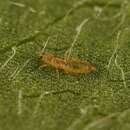Associations
(
الإنجليزية
)
المقدمة من BioImages, the virtual fieldguide, UK
Plant / resting place / on
larva of Anaphothrips obscurus may be found on live Poaceae
Remarks: season: 1-12
Plant / resting place / on
larva of Anaphothrips obscurus may be found on live Cereals
Remarks: season: 1-12
Conservation Status
المقدمة من University of Alberta Museums
Is considered a pest as it can be quite destructive to oat and wheat crops (Ananthakrishnan 1984).
- ترخيص
- cc-by-nc
- حقوق النشر
- University of Alberta Museums
Cyclicity
المقدمة من University of Alberta Museums
Adults collected in June, July, and August.
- ترخيص
- cc-by-nc
- حقوق النشر
- University of Alberta Museums
Distribution
المقدمة من University of Alberta Museums
Generally found in temperate regions of the world (Mound and Kibby, 1998), including Quebec, Ontario, Alberta & B.C. in Canada (Chiasson, 1986).
- ترخيص
- cc-by-nc
- حقوق النشر
- University of Alberta Museums
General Description
المقدمة من University of Alberta Museums
Body is around 1.5mm in length, not heavily reticulated, and yellowish. Antennae have 9 segments, though the suture between segments 6 and 7 is not complete. Antennal segments 3 and 4 have forked sense cones (Stannard, 1968). Pronotum lacks conspicuous setae. Macropterous forms are most common, but brachypterous and apterous forms may also occur (Bailey, 1957). Forewings are grayish yellow (Stannard, 1968).
- ترخيص
- cc-by-nc
- حقوق النشر
- University of Alberta Museums
Habitat
المقدمة من University of Alberta Museums
Various grasses and cereals, Poa sp., Calamagrostis canadensis, Bromus sp.
- ترخيص
- cc-by-nc
- حقوق النشر
- University of Alberta Museums
Life Cycle
المقدمة من University of Alberta Museums
Females of A. obscurus hibernate in the shoot sheaths of grasses over the winter. There is both a macropterous, and brachypterous form for females of this species (Ananthakrishnan, 1984). Males are unknown in North America (Heming).
- ترخيص
- cc-by-nc
- حقوق النشر
- University of Alberta Museums
Trophic Strategy
المقدمة من University of Alberta Museums
Feeds on grasses, or the heads of grasses (Stannard, 1968).
- ترخيص
- cc-by-nc
- حقوق النشر
- University of Alberta Museums

